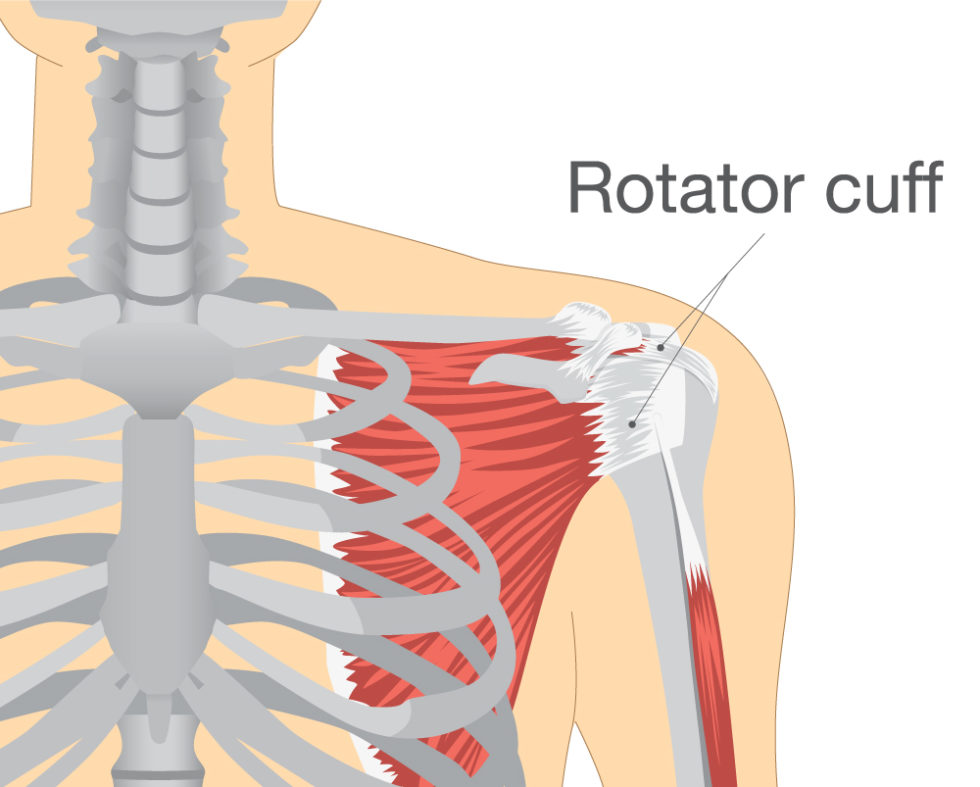
How do I know if I have a Rotator Cuff Injury?
Do you suspect an injury to, or inflammation of, your rotator cuff? Most commonly the pain from rotator cuff involvement is not in the shoulder but usually midway down the arm. Some common symptoms are shoulder/arm ache at night, especially if your roll onto it; or your shoulder/arm hurts when your reach forward overhead or sideways above shoulder level, into a cabinet or for items on a shelf. Your shoulder may hurt getting your seat belt on and off, getting your bra on and off, reaching into your back pocket. You can have tendinitis or a tear in any one muscle or any combination of the 4 rotator cuff muscles:
The primary function of the rotator cuff is to keep the ball of your upper arm bone (humerus) securely in the socket of your shoulder. The 4 muscles work together for this purpose when you reach overhead.
How do rotator cuff problems occur?
The most common involvement of the rotator cuff comes from degeneration of the rotator cuff that can occur from poor posture and with age. Tears happen more often over the age of 50. There are several ways that you can injury your rotator cuff. Rotator cuff tendinitis and tears can come from sports that involve overhead movement, such as throwing sports or swimming. Trauma from contact sports falls onto your arm can injure the rotator cuff tendons. Degeneration from repetitive stress or “cumulative trauma” can occur from repeated lifting overhead into cupboards, pantries, closets, or shelves.
The most common involvement of the rotator cuff comes from degeneration of the rotator cuff that can occur from poor posture and with age. Tears happen more often over the age of 50. There are several ways that you can injury your rotator cuff. Rotator cuff tendinitis and tears can come from sports that involve overhead movement, such as throwing sports or swimming. Trauma from contact sports falls onto your arm can injure the rotator cuff tendons. Degeneration from repetitive stress or “cumulative trauma” can occur from repeated lifting overhead into cupboards, pantries, closets, or shelves.
You may want to try rest, ice, and anti-inflammatories such as Tylenol or ibuprofen to ease your pain. You may need to train your rotator cuff muscles to function correctly again, and to train your shoulder blade stabilizer muscles to perform correctly.
A rotator cuff tear can either be either an acute injury, such as a fall or accident, or a chronic injury (normal age-related wear and tear with degeneration of the tendon). If the tear occurs from an injury, you may experience acute pain, a snapping sensation, and immediate weakness of the arm.
Chat With An Expert
If you have questions about how we can help you with headaches or back or neck pain, talk with one of our experts.
What Can Cause Rotator Cuff Injuries
Rotator Cuff Injuries are most often cause by an acute injury such as a fall or accident or by a chronic issue such as age, overuse, or arthritis.
Age: As our bodies age, they undergo natural changes. Over the age of 40, two different changes that occur in our bodies can lead to rotator cuff tears. First, a decrease in blood supply to the rotator cuff can lead to a diminished ability to heal and ultimately end in injury to the tendons. Second, as we age we tend to develop bone spurs in our joints. When a bone spur develops on the acromion, it rubs on the rotator cuff tendons every time the arm is raised. Over time, this can lead to a rotator cuff tear as well as shoulder tendonitis.
Arthritis: Forms of degenerative arthritis, such as osteoarthritis, can weaken the rotator cuff tendons and muscles leaving them susceptible to tears.
Overuse: Individuals who have occupations that require repetitive overhead motions or those who play sports are at a higher risk of experiencing chronic rotator cuff tears. This injury is common amongst construction workers, factory workers, and sports professionals and enthusiasts such as baseball players, swimmers, and golfers.

Physical Therapy for Rotator Cuff Injuries
The physical therapists at Lee Miller Rehabilitation are highly skilled, board-certified orthopedic clinical specialists with many years of experience treating shoulder and neck pain. We will do a thorough evaluation to determine the actual structure that is the cause of your pain. Because of the anatomy shoulder/arm, pain can come from many places. It is common that pinched nerves or arthritis in the neck and cause shoulder/arm pain. We can check your shoulder biomechanics to see how your rotator cuff is functioning during reaching, and how stable your shoulder blade is in assisting your shoulder movement. Treatment of rotator cuff may include manual therapy, postural re-education, specifically designed exercise program, dry needling, and pain-relieving modalities. Seeing a qualified physical therapist prior to an orthopedic surgeon can often help you delay or even avoid surgery altogether. If more invasive treatment is indicated, your Physical Therapist will refer you accordingly. In any event, don’t delay. As with most injuries, early treatment can shorten recovery and possibly avoid invasive surgery.
Request an Appointment
Specialized Care for Your Physical Therapy Needs
At Lee Miller Rehab, we are your strongest proponents for rehabilitation. We believe that being well-informed about your specific health situation is the first step in your recovery. We will educate you on the specific aspects of physical therapy that will provide you with the best outcome. We will work closely with you and monitor your progress, making adjustments along the way that will speed your healing.
If you have any questions or are would like to request an appointment, please fill out the form, and a member of our team will follow up with you ASAP.
